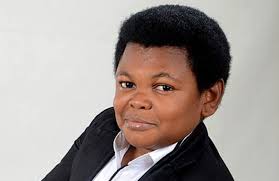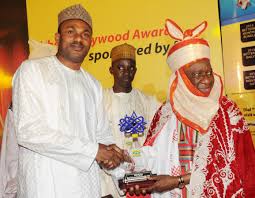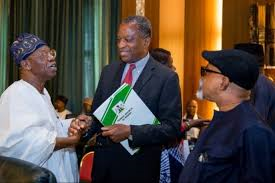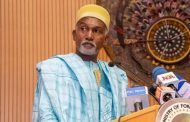By Adagbo ONOJA

One of Nollywood sensations across the world

Typical from Kannywood
Reel geopolitics is the name of the game. That is the game of husbanding cinematographic representation of reality to the help of national power in global politics. The power in question is the power that comes not from ballistic missiles but the power circulated through language use and the reality it constitutes. That is the power of Hollywood for the United States as the land of great guys and permanent winners. That is the power of Bollywood for the Indian global identity and that is the power of the emergent Chinese film industry for China as a rising great power. In other words, Hollywood is not just creativity but also creativity with inputs from intellectuals of statecraft around centres of American power.

Geoffrey Onyeama and Lai Mohammed, Nigeria’s ministers of Foreign Affairs and that of Information

Prof Ibrahim Bello-Kano

Prof Akwanya

Prof Saint Gbileka
Thus the CIA’s struggle with Hollywood is always an interesting part of most academic programmes in Popular Geopolitics – the study of the role of popular culture in global power politics. Without suggesting that Hollywood is just there to be used, the CIA, the armed forces and other such centres of state power do end up reaching an understanding here and there with Hollywood. And before you know, you could end up watching a film version of Orwell’s 1984 or any creative work for that matter in which the film ends without credits or some parts are narrated differently from the one Orwell actually wrote. Today, Bollywood is a main reason why there is a big debate whether India has entered the global media club or not because the Indian film industry has a global presence that has transcended the patronage of ethnic Indians.
Out of Africa, it is only Nigeria that has joined the club of reel geopolitics nations by evolving a completely indigenous and original film industry with a global presence beyond the entertainment of just ‘ethnic’ Nigerians in the Diaspora or even Africans but also other races and cultural identities. Nollywood, Kannywood and other expressions of this recent cultural innovation from Nigeria under the Nollywood umbrella name has, in fact, reified Nigeria globally in a way that makes nonsense of separatist sentiments at home. How else does one view the phenomenon whereby the Nigerian, irrespective of his or her ethnic identity, is instantly identified in terms of one feature or the other as popularized by one Nollywood film or the other.
Nollywood also seems to answer what an Africanist academic called the hunger to see a black person playing in the movie, taking charge. And so, from Kenya to South Africa, Addis to New York, Nollywood is representing Nigeria via an art form of diplomacy that strikes at the core of ownership of the African story as well as at the idea of Africa’s contribution to human civilisation. In a 2013 essay, Olabanji Akinola noted how “The unprecedented rise of Nollywood in the past two decades attest to its success in uniquely telling African stories from the perspective of Africans, a storytelling role that had for too long been left in the hands of many who portrayed the continent as the bastion of dangers and backwaters of human civilisation”.
Nollywood and its other sister woods in Nigeria are criticised on many grounds such as quality of production and producers, the message, entrapment in rituals and nudist proclivities, among others. Still, its images of the fantastic neighborhood, rural idyllic, portrait of real life situations such as someone riding the bicycle or carrying gourds of palm wine and so on strike at the core of many souls from Cuba to Brazil, from the Caribbean to the United States of America, from Europe to the Indian sub-continent. It is reported that, in Kenya, there is a profound admiration for Nigerian women, not in romantic sense but a craving for the image acted out in Nollywood; the woman who can shout or has the carriage of being in charge. In many African countries, Nigerians are greeted as Igwe!, a transnationalisation of the palace chorus of approval among the Igbos.
Nollywood has a mystique. It is what Akin Adesokan who wrote his doctoral thesis on an aspect of it at Cornel University in the United States calls the revolution from below. And he goes on to write how “This message of commercial success and aesthetic daring has attracted international attention: feature articles in mainstream US media; from Time to The Boston Globe; a BBC documentary; several academic monographs in the mill and even the consistent patronage of the French Ministry of Cooperation”. Adesokan’s is a 2004 voice. By 2013, Akinola could write: “With over 2000 movies produced annually and an estimated $20m earnings in 2006, the Nigerian film industry is now the third largest in the world after those of the United States, (Hollywood) and India, (Bollywood)”
Nollywood Studies has emerged as a sub-discipline. No such academic project would be worth the while of the universities which have introduced it if it doesn’t include deep intrusion into each and every of Nigeria’s cultural ensemble.
So, in multiple ways, Nollywood offers Nigeria a very potent instrument for projecting national power. But Nigeria is not a known enthusiast of extravagant cultural diplomacy or of soft power techniques. These are where it would have operationalised an instrumentalist view of cinematography within the diplomatic amoury. Would Nollywood change this or not? What is there to suggest that Nigeria is coming to grips with the challenge of reel geopolitics? What are her prospects? Meanwhile, what hopes, fears and reservations do critics and the policy mill have regarding Nollywood, especially the issue of message, the entrapment in rituals and juju? These are the questions that the second and third parts of this report will turn to.




























